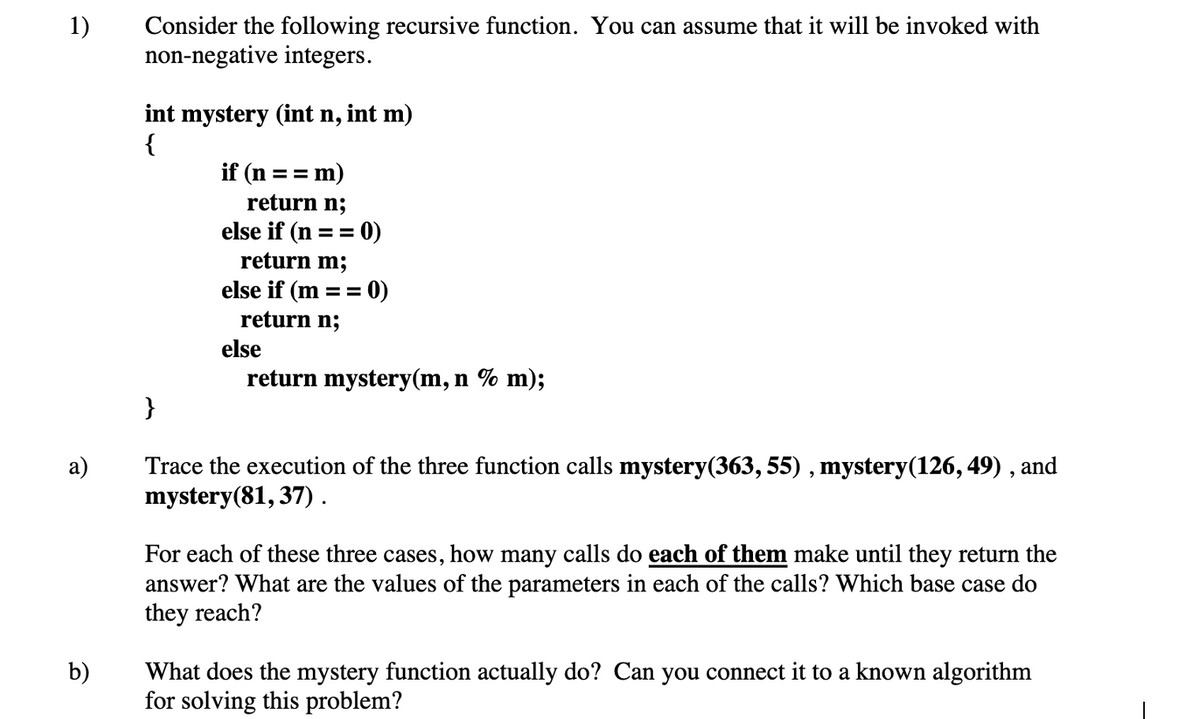1) a) b) Consider the following recursive function. You can assume that it will be invoked with non-negative integers. int mystery (int n, { } = m) if (n == return n; int m) else if (n == 0) return m; else if (m == 0) return n; else return mystery(m, n % m); Trace the execution of the three function calls mystery(363, 55), mystery(126, 49), and mystery(81, 37). For each of these three cases, how many calls do each of them make until they return the answer? What are the values of the parameters in each of the calls? Which base case do they reach? What does the mystery function actually do? Can you connect it to a known algorithm for solving this problem?
1) a) b) Consider the following recursive function. You can assume that it will be invoked with non-negative integers. int mystery (int n, { } = m) if (n == return n; int m) else if (n == 0) return m; else if (m == 0) return n; else return mystery(m, n % m); Trace the execution of the three function calls mystery(363, 55), mystery(126, 49), and mystery(81, 37). For each of these three cases, how many calls do each of them make until they return the answer? What are the values of the parameters in each of the calls? Which base case do they reach? What does the mystery function actually do? Can you connect it to a known algorithm for solving this problem?
C++ Programming: From Problem Analysis to Program Design
8th Edition
ISBN:9781337102087
Author:D. S. Malik
Publisher:D. S. Malik
Chapter15: Recursion
Section: Chapter Questions
Problem 1TF
Related questions
Question
Solve the questions on recursive function; please refer to the screenshot;

Transcribed Image Text:1)
a)
b)
Consider the following recursive function. You can assume that it will be invoked with
non-negative integers.
int mystery (int n,
{
}
= m)
if (n ==
return n;
int m)
else if (n == 0)
return m;
else if (m == 0)
return n;
else
return mystery(m, n % m);
Trace the execution of the three function calls mystery(363, 55), mystery(126, 49), and
mystery(81, 37).
For each of these three cases, how many calls do each of them make until they return the
answer? What are the values of the parameters in each of the calls? Which base case do
they reach?
What does the mystery function actually do? Can you connect it to a known algorithm
for solving this problem?
Expert Solution
This question has been solved!
Explore an expertly crafted, step-by-step solution for a thorough understanding of key concepts.
Step by step
Solved in 2 steps

Recommended textbooks for you

C++ Programming: From Problem Analysis to Program…
Computer Science
ISBN:
9781337102087
Author:
D. S. Malik
Publisher:
Cengage Learning

C++ Programming: From Problem Analysis to Program…
Computer Science
ISBN:
9781337102087
Author:
D. S. Malik
Publisher:
Cengage Learning